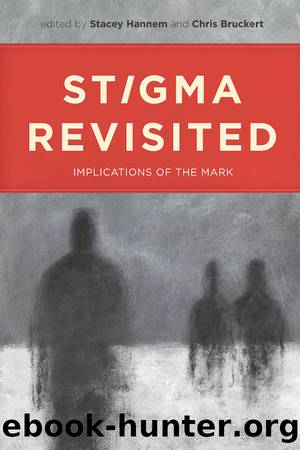Stigma Revisited by Stacey Hannem Chris Bruckert

Author:Stacey Hannem, Chris Bruckert [Stacey Hannem, Chris Bruckert]
Language: eng
Format: epub
ISBN: 9780776607832
Barnesnoble:
Publisher: University of Ottawa Press
Published: 2012-10-06T00:00:00+00:00
NOTES
1 While I utilize the family members of prisoners as a particular example of the transmission of stigma, note that many of the concepts presented here may also be applied to the close associates of other groups of labelled and stigmatized individuals, such as the family members of mentally ill persons, homosexual persons, those who work in the sex trade, and others.
2 See chapter 1, this volume, for a thorough discussion of symbolic and structural stigmas.
3 The observant reader will notice that this, in fact, totals thirty âconversationsâ; two individuals participated in both a focus group and an interview, bring the total number of persons to twenty-eight.
4 Admittedly, research around prisoners in same-sex relationships is lacking and certainly warrants further exploration.
5 When a woman is imprisoned, it is relatively rare that her male partner would endeavour to sustain the relationship throughout the period of incarceration or assume the care of minor children (Casey-Acevedo and Bakken 2002; Maidment 2006b). More commonly, the relationship will dissolve, or the woman may have been a single mother at the outset of her sentence. In these cases, again other women bear the collateral cost of incarceration as children are sent to live with and be raised by maternal grandmothers or aunts. In the absence of these supportive kin relationships, children are placed in the foster care system.
6 The commissionerâs directive on the searching of visitors to federal penitentiaries states, âIn all facilities except minimum security and Community Correctional Centres, there will be a routine non-intrusive search of all visitors upon entering the institutionâ (Correctional Service of Canada 2004a, 3). The precise nature and procedures for these searches are determined by the Institutional Heads of each prison who are required by the directive to establish an Institutional Search Plan unique to the security needs of the institution under their care (Correctional Service of Canada 2004a). Although the directive states that there is also to be a protocol for searching staff upon entry to the prison, policy allows the Institutional Head a substantial amount of discretion in dictating the scope and types of searches employed.
7 The Correctional Service Review Panel was an independent panel appointed by the Conservative government under Prime Minister Stephen Harper to review the operations of the Correctional Service of Canada and to formulate recommendations for improving the correctional system.
8 The scope of this chapter does not allow further exploration or comment on this phenomenon, but further study of public views toward stigmatized individuals could provide insight into the role of personal experience in the assignment of stigmatizing values.
Download
This site does not store any files on its server. We only index and link to content provided by other sites. Please contact the content providers to delete copyright contents if any and email us, we'll remove relevant links or contents immediately.
Cecilia; Or, Memoirs of an Heiress — Volume 1 by Fanny Burney(32029)
Cecilia; Or, Memoirs of an Heiress — Volume 3 by Fanny Burney(31441)
Cecilia; Or, Memoirs of an Heiress — Volume 2 by Fanny Burney(31391)
The Great Music City by Andrea Baker(30762)
We're Going to Need More Wine by Gabrielle Union(18613)
All the Missing Girls by Megan Miranda(14637)
Pimp by Iceberg Slim(13758)
Bombshells: Glamour Girls of a Lifetime by Sullivan Steve(13670)
Fifty Shades Freed by E L James(12892)
Talking to Strangers by Malcolm Gladwell(12837)
Norse Mythology by Gaiman Neil(12796)
For the Love of Europe by Rick Steves(11343)
Crazy Rich Asians by Kevin Kwan(8868)
Mindhunter: Inside the FBI's Elite Serial Crime Unit by John E. Douglas & Mark Olshaker(8673)
The Lost Art of Listening by Michael P. Nichols(7142)
Enlightenment Now: The Case for Reason, Science, Humanism, and Progress by Steven Pinker(6858)
The Four Agreements by Don Miguel Ruiz(6298)
Bad Blood by John Carreyrou(6260)
Weapons of Math Destruction by Cathy O'Neil(5805)
